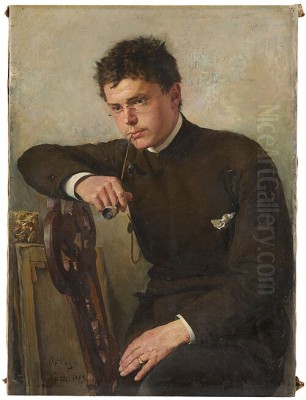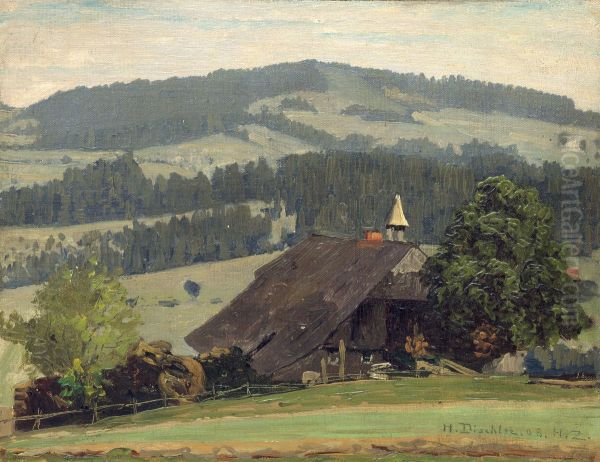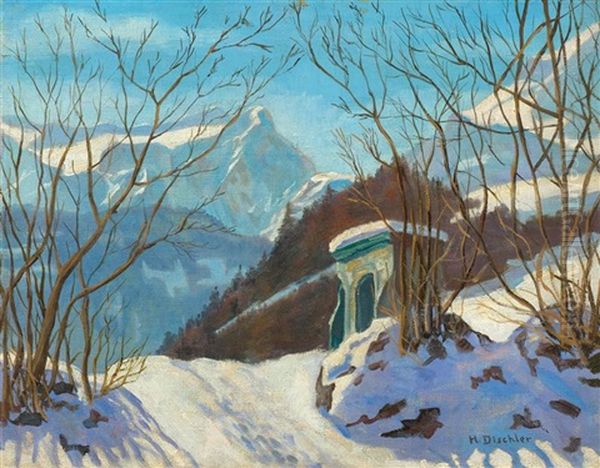
Hermann Dischler, a name intrinsically linked with the ethereal, snow-laden landscapes of Germany's Black Forest, stands as a significant, if sometimes overlooked, figure in early 20th-century German art. His dedication to capturing the unique atmosphere of this region, particularly its winter visage, earned him the affectionate moniker "Schneemaler" (Snow Painter). Through a combination of traditional artistic skill and innovative techniques, Dischler created a body of work that not only celebrated the beauty of his homeland but also served as a meticulous record of its changing face.
Early Life and Artistic Formation
Born on September 25, 1866, in Freiburg im Breisgau, a city nestled on the western edge of the Black Forest, Hermann Dischler was geographically and spiritually poised to become one of the region's foremost artistic chroniclers. His formal artistic training took place at the prestigious Großherzoglich-Badische Kunstschule (Grand Ducal Baden Art School) in Karlsruhe, a prominent center for art education in Germany at the time. He studied there from 1885 to 1894, a period that allowed him to absorb the prevailing artistic currents and hone his technical skills.
A pivotal influence during his formative years was his professor, Gustav Schönleber (1851-1917). Schönleber was a highly respected landscape painter, known for his realistic depictions of German and Italian scenery, often imbued with a subtle impressionistic sensibility in his handling of light and atmosphere. Under Schönleber's tutelage, Dischler would have been encouraged to develop a keen eye for observation and a disciplined approach to rendering nature. The Karlsruhe school, at this time, was fostering a tradition of landscape painting that valued both fidelity to nature and an emerging interest in capturing transient effects of light and weather, moving away from the more romanticized or allegorical landscapes of earlier generations. Artists like Hans Thoma (1839-1924), though older, also had strong ties to Karlsruhe and the Black Forest, championing a style rooted in German tradition and local scenery, which likely resonated with Dischler.
The Call of the Black Forest: Hinterzarten and the Künstlerhaus

Upon completing his studies in 1894, Dischler made a decisive move that would define his career: he established his studio in Hinterzarten, a picturesque village deep within the High Black Forest (Hochschwarzwald). This was not merely a change of address but a profound commitment to his chosen subject matter. He named his studio the "Künstlerhaus" (Artist's House), and it became a hub for his creative endeavors and a place where he regularly held art exhibitions, showcasing his own work and likely that of other regional artists.
Living and working in Hinterzarten immersed Dischler in the daily rhythms and seasonal transformations of the Black Forest. This direct, sustained engagement with the landscape was crucial to his artistic practice. He was not an artist who painted the Black Forest from memory or fleeting visits; he was an inhabitant, a keen observer of its subtle moods and dramatic shifts. This deep connection allowed him to capture the essence of the region with an authenticity that resonated with viewers. His focus on the Black Forest aligned with a broader cultural interest in "Heimatkunst" (homeland art) in Germany, which emphasized regional identity and the depiction of local landscapes and traditions, a sentiment also seen in the work of painters like Wilhelm Hasemann (1850-1913), who became famous for his portrayals of Gutach Valley life in the Black Forest.
The "Schneemaler": Master of Winter Landscapes
While Dischler painted the Black Forest in all its seasonal glories, it was his masterful depictions of winter that truly set him apart and earned him the title "Schneemaler." He possessed an extraordinary ability to render the myriad textures and tones of snow: the crisp, sunlit expanses, the deep blue shadows, the soft, muffling blankets on fir trees, and the icy sheen on frozen streams. His winter scenes are not desolate or barren; instead, they often convey a sense of profound stillness, pristine beauty, and the resilient spirit of nature.

Works such as "Gefrorene Tannen auf dem Feldberg" (Frozen Firs on the Feldberg) from 1923 exemplify his skill. The Feldberg, the highest peak in the Black Forest, provided a dramatic backdrop for his explorations of winter's majesty. In this painting, one can almost feel the biting cold and witness the intricate patterns of frost and snow clinging to the trees, set against a vast, atmospheric sky. Another notable work, "Wintermorgen bei St. Märgen" (Winter Morning near St. Märgen) from 1931, captures the serene light of a winter dawn, illuminating a snow-covered village and the surrounding hills. These paintings are characterized by their careful composition, nuanced color palettes, and an almost palpable sense of atmosphere. His dedication to the winter motif can be compared to that of Scandinavian painters like Frits Thaulow (1847-1906), who also specialized in capturing the effects of snow and ice on landscapes, though Dischler's focus remained resolutely on his native region.
Artistic Technique: Photography and Precision
A fascinating aspect of Dischler's working method was his innovative use of photography. Beginning in the late 19th century, he embraced the camera not merely as a tool for sketching or aide-mémoire, but as an integral part of his painting process. He would take photographs of the landscapes he intended to paint, often from challenging vantage points achieved through his passion for skiing. These photographs, capturing specific light conditions and intricate details, were then projected onto his canvases.
This technique allowed Dischler to achieve an exceptionally high degree of accuracy and detail in his paintings. The precise rendering of tree branches, the subtle gradations of snowdrifts, and the specific topography of the Black Forest landscapes in his works owe much to this photographic underpinning. While some purists of the era might have viewed such reliance on mechanical aids with skepticism, Dischler's approach enabled him to create images that were both artistically compelling and remarkably faithful to reality. Consequently, his paintings are now considered not only works of art but also valuable historical documents, offering a precise visual record of the Black Forest landscape as it appeared in the early 20th century. This use of photography aligns him with other artists of the period who explored its potential, such as Thomas Eakins (1844-1916) in America, though Dischler's direct projection method was quite specific.
Beyond the Snow: Other Themes and Subjects
Although renowned as the "Schneemaler," Dischler's oeuvre was not exclusively confined to winter scenes. He also depicted the Black Forest in other seasons, capturing the vibrant greens of spring and summer, and the rich hues of autumn. His interest extended to the human presence within this natural environment. For instance, his painting "Ospelehof farm" (1908) showcases a traditional Black Forest farm, likely depicting the rhythms of rural life and labor. These works demonstrate his broader engagement with the region's character, encompassing its agricultural heritage as well as its wilder, natural aspects.
His style, while predominantly realistic and detailed, sometimes showed a sensitivity to the atmospheric effects and light play associated with Impressionism, likely an influence from his teacher Schönleber and the broader European art scene. However, unlike the leading German Impressionists such as Max Liebermann (1847-1935), Lovis Corinth (1858-1925), or Max Slevogt (1868-1932), who often focused on urban scenes, portraits, or more dynamic, light-filled landscapes with looser brushwork, Dischler's primary commitment was to the detailed, almost documentary, representation of his specific regional subject matter. His approach was perhaps closer in spirit, though different in technique, to the meticulous realism of Wilhelm Leibl (1844-1900) and his circle, who also emphasized careful observation and fidelity to the subject.
Associations and Collaborations: A Voice for Black Forest Art
Hermann Dischler was not a solitary artist working in isolation. He was actively involved in the regional art community and played a role in promoting the artists of the Black Forest. He served as the chairman of the "Breisgauer Fünf" (Breisgau Five), an artists' association, indicating a position of leadership and respect among his peers. The exact composition and activities of this group warrant further research, but its existence points to a collective artistic identity in the Breisgau region.
Furthermore, in 1926, Dischler was instrumental in founding the exhibition association "Die Schwarzen Waelder" (The Black Foresters). This group, which aimed to showcase the work of artists dedicated to depicting the Black Forest, included other notable regional painters such as Curt Liebich (1868-1937), Julius Heffner (1877-1951), Wilhelm Nagel (1866-1945), and Wilhelm Wickertsheimer (1886-1968). Ludwig Zorn (1865-1921) was another contemporary who shared an interest in the Black Forest landscape. The formation of "Die Schwarzen Waelder" suggests a concerted effort to create a platform for artists who, like Dischler, found their primary inspiration in this unique German landscape. Such regional artist groups were common in Germany, like the Worpswede Colony near Bremen, which included artists like Paula Modersohn-Becker (1876-1907) and Otto Modersohn (1865-1943), who also focused on their local environment.
Dischler in the Context of His Time
Dischler's career spanned a period of significant artistic and social change in Germany. He began his studies during the Wilhelmine Era, a time of industrial growth and burgeoning national pride, which also saw a romantic appreciation for Germany's natural landscapes and cultural heritage. His dedication to the Black Forest can be seen within this context of "Heimat" sentiment.
While major avant-garde movements like Expressionism were taking hold in German cities with groups like Die Brücke (The Bridge) and Der Blaue Reiter (The Blue Rider), Dischler and many of his regional contemporaries maintained a more traditional, representational approach. His work did not engage with the radical formal innovations or the intense psychological explorations of artists like Ernst Ludwig Kirchner (1880-1938) or Franz Marc (1880-1916). Instead, Dischler's art offered a vision of enduring natural beauty and meticulous craftsmanship. His focus on detailed realism, aided by photography, set him apart from the more painterly or emotionally charged styles of many contemporaries, yet it provided a unique and valuable contribution. One might also consider the work of landscape painters associated with the Berlin Secession, such as Walter Leistikow (1865-1908), who, while more aligned with Impressionist and Art Nouveau tendencies, also focused on capturing the specific character of German landscapes, albeit different regions.
His personal interest in skiing, which he used to access remote winter landscapes for his photographic studies, also speaks to the era's growing engagement with outdoor recreation and the appreciation of nature through physical activity. This adventurous spirit undoubtedly informed the unique perspectives and intimate knowledge evident in his winter paintings.
Legacy and Recognition
Hermann Dischler passed away on March 20, 1935, in Hinterzarten, the village that had been his home and inspiration for over four decades. He left behind a significant legacy as one of the most dedicated and skilled painters of the Black Forest. His works continue to be appreciated for their aesthetic quality, their technical proficiency, and their historical value.
In recent years, there has been a renewed interest in his art. His paintings appear in auctions, with some fetching considerable prices, as evidenced by sales in 2022 where works were sold for amounts ranging from €3,000 to €17,000. This market interest reflects a lasting appreciation for his unique vision and skill. Museums and collections, particularly in the Black Forest region, preserve his work, ensuring that future generations can experience his depictions of this iconic German landscape. The Augustiner Museum in Freiburg, for example, holds works by Dischler and other Black Forest painters, providing context for his artistic contributions.
His meticulous, photographically-informed paintings of the Black Forest, especially its winter attire, offer more than just picturesque views. They are a testament to an artist's deep love for his homeland, a pioneering use of technology in the service of art, and a valuable record of a landscape that continues to captivate and inspire. Hermann Dischler, the "Schneemaler," successfully carved a distinct niche for himself in the rich tapestry of German art, ensuring his place as a master of the winter landscape. His paintings invite us to see the Black Forest through his eyes – with precision, reverence, and a profound appreciation for its enduring, often snow-covered, beauty.